#unique mid century designs
Text
Website : https://www.midmod.pt/
Address : Rua São João Nepomuceno 32B, Lisboa, Portugal 1250-233
Mid Mod, established in 2017 in Lisbon's Lapa neighborhood, specializes in Mid Century Modern pieces from the 50s, 60s, and 70s. Curated by Henrique Salgado, the store offers an eclectic collection of original pieces by acclaimed designers. Known for its unique blend of elegant design and vibrant colors, Mid Mod ensures each item's authenticity and origin. The store extends its expertise through various bespoke services, including interior and lighting consultancy, plant consultancy, home and event staging, rental, and restoration. Embracing the art-design connection, Mid Mod collaborates with contemporary artists and showcases international works. Customers can visit the showroom by appointment or explore the collection online, with international shipping available.
Facebook : https://www.facebook.com/midmodlx/
Keywords:
Vintage furniture
Vintage furniture Lisbon
Lighting design services
Contemporary Portuguese artists
Interior design near me
Mid-century modern design
Portuguese contemporary artists
Restoration services near me
mid century modern design
original 20th century pieces
eclectic showroom collection
interior design consultancy
plant consultancy for homes
event staging and home decor
furniture rental services
restoration of vintage items
unique mid century designs
internationally acclaimed designers
vibrant mid century aesthetics
authentic vintage furniture
curated furniture collection
collaborative art and design
international artist collaborations
sustainable furniture choices
eco conscious vintage living
mid century modern authenticity
home decor with historical value
artistic furniture design
bespoke home furnishing services
vintage design showroom lisbon
exclusive mid century furnishings
authentic designer furniture
vintage art and design fusion
creative interior design solutions
unique vintage home accessories
stylish furniture for homes
mid century inspired decor
classic 20th century pieces
modern lighting design
plant styling for homes
event decor and staging
furniture leasing services
vintage item restoration
trendsetting mid century designs
designers with international acclaim
timeless mid century aesthetics
vintage authenticity in decor
curated art and design
sustainable and chic furniture
eco friendly vintage living
authentic mid century appeal
historic value in home decor
artistic and functional furniture
custom vintage home accessories
lisbon mid century modern design
original 20th century pieces lisbon
eclectic showroom lisbon
interior design consultancy in lisbon
lighting design lisbon
plant consultancy lisbon
event staging lisbon
home decor in lisbon
furniture rental lisbon
restoration services lisbon
mid century designs lisbon
lisbon acclaimed designers
lisbon mid century aesthetics
vintage furniture in lisbon
curated collection lisbon
art and design lisbon
contemporary artists portugal
international artist collaborations lisbon
sustainable furniture lisbon
eco conscious living lisbon
lisbon mid century authenticity
historical value decor lisbon
artistic furniture lisbon
bespoke home furnishing lisbon
vintage showroom lisbon
exclusive furnishings lisbon
authentic designer lisbon
vintage art fusion lisbon
creative interior design lisbon
vintage furniture near me
mid century modern near me
original 20th century near me
eclectic showroom near me
lighting design near me
plant consultancy near me
event staging near me
home decor near me
furniture rental near me
mid century designs near me
acclaimed designers near me
mid century aesthetics near me
vintage furniture nearby
curated collection nearby
art and design nearby
contemporary artists nearby
international artist collaborations nearby
sustainable furniture near me
#Vintage furniture Lisbon#Lighting design services#Contemporary Portuguese artists#Interior design near me#Mid-century modern design#Portuguese contemporary artists#Restoration services near me#mid century modern design#original 20th century pieces#eclectic showroom collection#interior design consultancy#plant consultancy for homes#event staging and home decor#furniture rental services#restoration of vintage items#unique mid century designs#internationally acclaimed designers#vibrant mid century aesthetics#authentic vintage furniture#curated furniture collection#collaborative art and design#international artist collaborations#sustainable furniture choices#eco conscious vintage living#mid century modern authenticity#home decor with historical value#artistic furniture design#bespoke home furnishing services#vintage design showroom lisbon#exclusive mid century furnishings
1 note
·
View note
Text

"Happy Spiral" - a vibrant and uplifting art print that is sure to bring a smile. The swirling spiral symbolizes the journey to find joy and serves as a daily reminder to take a moment and create something beautiful.
#haapy spiral#colorful face#line art#one line drawing#abstract art#modern wall art#contemporary art prints#plants#boho#bohemian interior#blue bedroom#wooden furniture#wooden lamp#original art#mid-century modern#unique illustration#one-of-a-kind#artistic room#guste design
3 notes
·
View notes
Photo
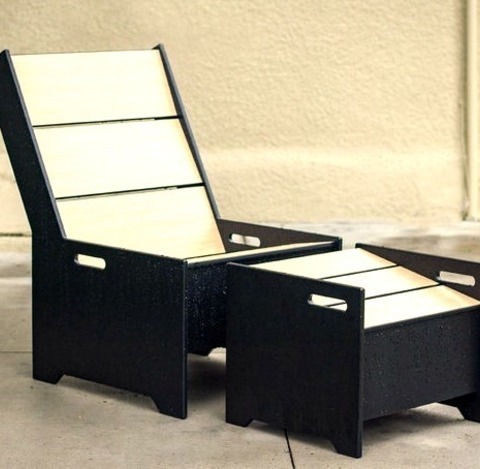
Concrete Slab Minneapolis
Inspiration for a mid-sized modern backyard concrete patio remodel with no cover
#unique landscape design ideas#moss covered tree#beige stucco siding#mid-century modern furniture#concrete hardscape
0 notes
Photo
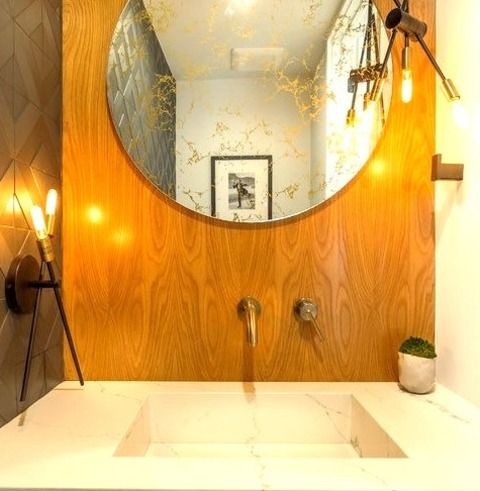
Midcentury Powder Room - Powder Room
#Powder room - mid-sized 1950s powder room idea with an integrated sink mid century modern#modern#home#hollywood hills#design#open space#unique
0 notes
Photo
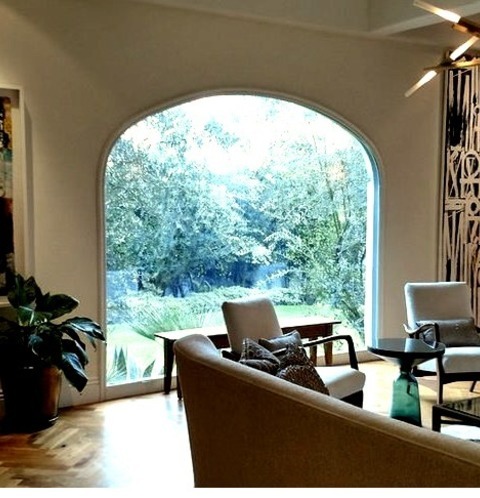
Orange County Music Room
#Example of a mid-sized mid-century modern open concept light wood floor living room design with a music area#beige walls#no fireplace and no tv wrought iron table#unique lighting fixture#white walls#grey area rug#bell shaped table#metallic accents#house plants
0 notes
Text
the major takeaway from last night is that Karl Lagerfeld was more of a personality than a designer and that Yves Saint Laurent was the clear winner of that rivalry.
For those who aren’t familiar, Karl Lagerfeld and Yves Saint Laurent were both fashion wunderkinds who emerged in the late 1950s, both appointed heads of major brands at the same time, and had very intense rivalry. Yves Saint Laurent took over Dior after the passing of Christian Dior, helped cement the brand as a major player in fashion, and then after a disastrous stint being drafted into the French army, built his own fashion brand that went down in history with its unique and diverse and always evolving looks.
Karl was always kind of behind Yves. He designed for a lot of major fashion brands, and managed to establish himself at the top of the game at Chloé, but he didn’t get his full on legendary status until he took over Chanel in 1983. This history of the Chanel brand was already pretty frought, with Coco Chanel modernizing and defining the fashion of the 1920s and 30s, but being forced to shut down during World War 2, during which she collaborated with the Nazis. Behind the Bastards did a pretty great two episodes on her. When the brand returned in the 60s, fashion had changed tremendously. Dior, Givenchy, Balenciaga, and Balmain had all taken over mid-century fashion, and now that aesthetic was being taken over by mod, the miniskirt, and the likes of Mary Quant, Pierre Cardin, and Paco Rabanne. So when Chanel came back it was largely seen as a stuffy old lady brand, which it remained until Karl took it over.
Now, this is where Karl actually did something really impressive that you honestly can’t take away from him: he took a fashion house in severe decline, one that had been in its flop era for literal decades, and he made it hip again, while still managing to stay true to the ethos that Coco Chanel had laid out.
Chanel is clean, minimalistic, and classy. It is easy to wear, effortless, and always extremely glamorous, which is what made it so iconic in the 20s and 30s. Given that the 50s and 60s were all about making a fucking effort, the thing that the brand managed to keep doing well was its suits. You know what kind of suits I’m talking about. Tweed jackets and midi skirts, neat tailoring, delicate pastel colors, pearls and camellias and chains. It’s not so much that it was edgy and exciting but it was expensive and it was *Chanel* and people wore it for the status symbol alone. That is what Karl took advantage of and managed to re-invent.
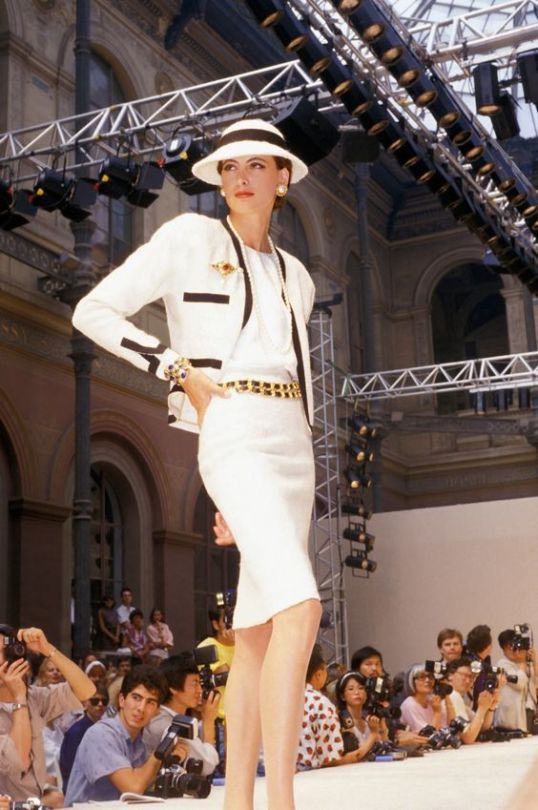
That sort of aesthetic fit perfectly into the you-can-never-be-too-rich-or-too-skinny 80s, when wearing status symbol clothing was everything.
Then, in the 90s, he managed to keep things exciting by following exactly what was on-trend at the time and incorporating elements of street wear and hip-hop.

However, after that, he kind of lost his edge and just rested on “it’s Chanel” rather than actually pushing the fashion envelope. By the time he died in 2019, he was a fucking dinosaur and fashion had long since moved past him. The thing that he was ultimately most well known for was his own very distinctive look and flamboyant personality.
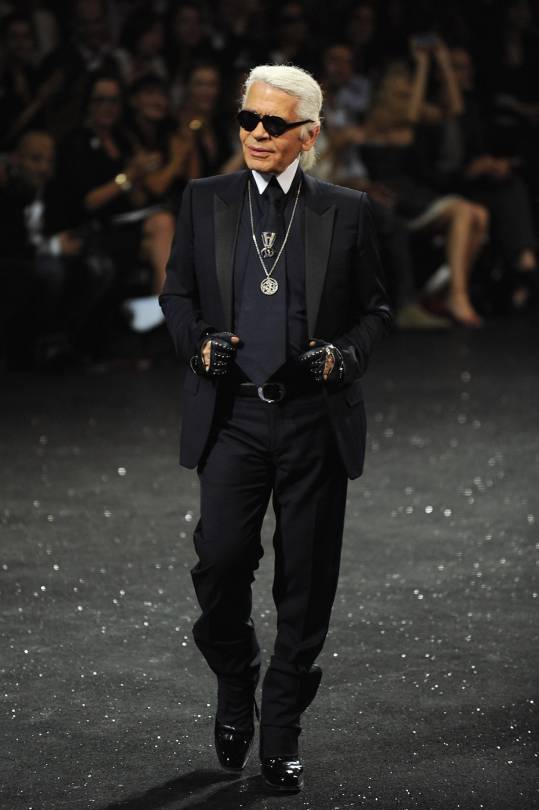
Before I ever started studying fashion, I knew who Karl was because I’d seen him so many times, and I’d seen parodies of him so many times. I knew *him* but I didn’t really know his work. And I think having an incredibly boring Met Gala dedicated to him reveals that: his actual artistic legacy is skinnier than the models he used to berate. Karl Lagerfeld built his brand on his diva personality, and that sort of personality and outlook just isn’t hip anymore. Fashion is always about moving forward, and Lagerfeld’s beliefs should remain fossilized in the past.
2K notes
·
View notes
Text

Aw, maaaannn, another one of my dream houses is back on the market, but this time, instead of the $3.5M price tag it had in 2018, it's now listed for $9.75M + $1,967mo. common charge. The 1910 building is located in the East Village, a desirable trendy part of New York City. It's a large duplex with 5bds, 4.5ba.
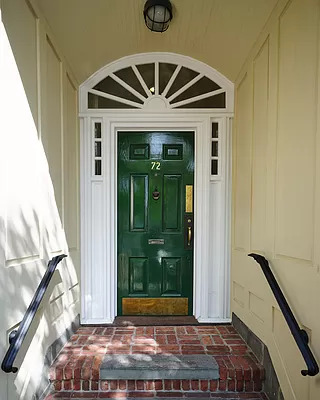
The entrance is thru an iron gate and a forest green door.


The property consists of a penthouse with a cottage on the roof.


In the living room is a lovely fireplace and a mezzanine on the 2nd level opens the space, giving it some architectural interest.
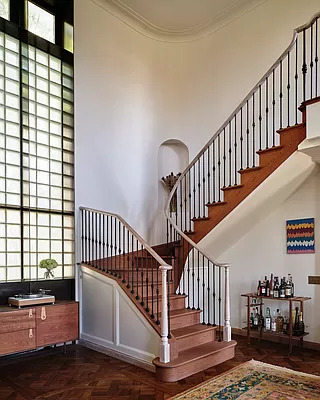
The home was renovated and has a renewed staircase, yet retains an original niche. A ceiling-high glass block window lets in light.

Open concept dining room lined with windows for lots of natural light.
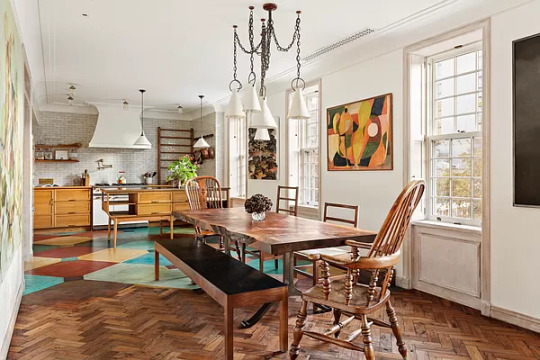
The open space ends with the kitchen.

Love the vintage look flooring. The kitchen island is unique- it looks like a mid-century modern sideboard.
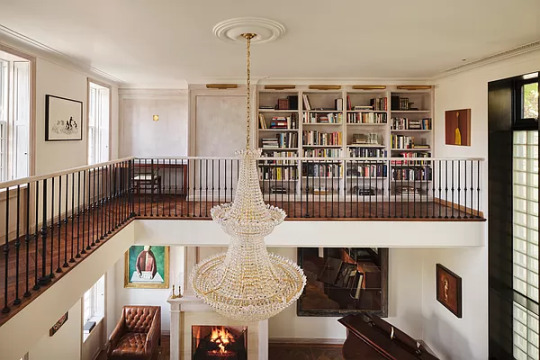
The mezzanine is basically just a walkway, but it has a wall of shelving and enough room for a chair or two.

There's also a nook for a small desk or writing table.


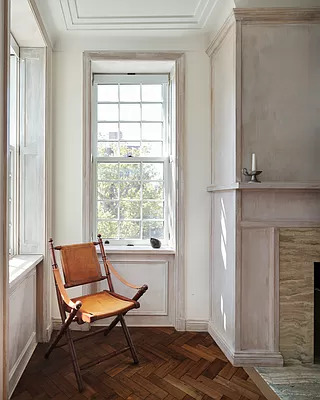
The primary bedroom is a nice size, gets good natural light, and has a small nook for a chair, plus a lovely fireplace. It also has a view of the patio. And, it's located in the rooftop cottage.
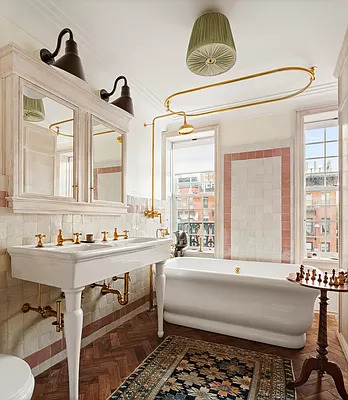
Very nicely remodeled vintage style bath.
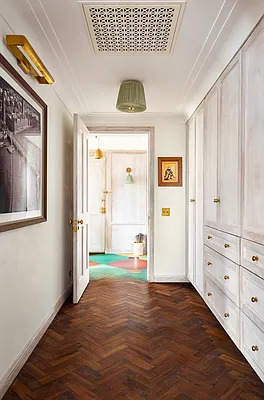

Hallway with a built-in closet and a bedroom used as a TV room.
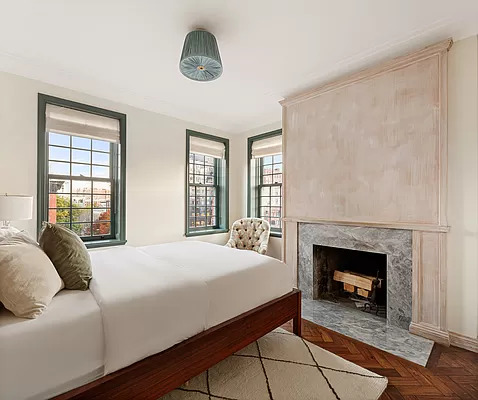
This bedroom is designed the same as the primary, but on a smaller scale.


Lively turquoise subway tile bath and bedroom #3.


And, another lovely tiled bath with bedroom #4.


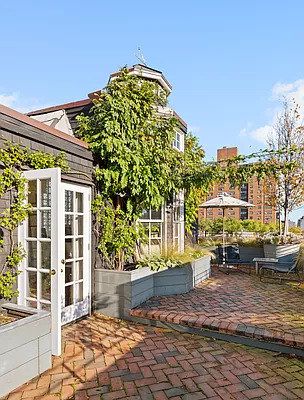
The rooftop cottage and brick patio looks like a beautiful home you'd find on the ground.

It's like the best of both worlds, living in the city and the country.

There're even trees, lawn & gardens.

View of the city.
166 notes
·
View notes
Text

Remnants of a Legendary Typeface Have Been Rescued From the Thames River
Doves Type was thrown into the water a century ago, following a dispute between its creators.
The depths of the river Thames in London hold many unexpected stories, gleaned from the recovery of prehistoric tools, Roman pottery, medieval jewelry, and much more besides. Yet the tale of the lost (and since recovered) Doves typeface is surely one of the most peculiar.
A little over a century ago, the printer T.J. Cobden-Sanderson took it upon himself to surreptitiously dump every piece of this carefully honed metal letterpress type into the river. It was an act of retribution against his business partner, Emery Walker, whom he believed was attempting to swindle him.
The pair had conceived this idiosyncratic Arts and Crafts typeface when they founded the Doves Press in the London’s Hammersmith neighborhood, in 1900. They worked with draftsman Percy Tiffin and master punch-cutter Edward Prince to faithfully recall the Renaissance clarity of 15th-century Venetian fonts, designed by the revolutionary master typographer Nicolas Jensen.

With its extra-wide capital letters, diamond shaped punctuation and unique off-kilter dots on the letter “i,” Doves Type became the press’s hallmark, surpassing fussier typographic attempts by their friend and sometime collaborator, William Morris.
The letterforms only existed as a unique 16pt edition, meaning that when Cobden-Sanderson decided to “bequeath” every single piece of molded lead to the Thames, he effectively destroyed any prospect of the typeface ever being printed again. That might well have been the case, were it not for several individuals and a particularly tenacious graphic designer.
Robert Green first became fascinated with Doves Type in the mid-2000s, scouring printed editions and online facsimiles, to try and faithfully redraw and digitize every line. In 2013, he released the first downloadable version on typespec, but remained dissatisfied. In October 2014, he decided to take to the river to see if he could find any of the original pieces.

Using historical accounts and Cobden-Sanderson’s diaries, he pinpointed the exact spot where the printer had offloaded his wares, from a shadowy spot on Hammersmith bridge. “I’d only been down there 20 minutes and I found three pieces,” he said. “So, I got in touch with the Port of London Authority and they came down to search in a meticulous spiral.” The team of scuba divers used the rather low-tech tools of a bucket and a sieve to sift through the riverbed.
Green managed to recover a total of 151 sorts (the name for individual pieces of type) out of a possible 500,000. “It’s a tiny fraction, but when I was down by the river on my own, for one second it all felt very cosmic,” he said. “It was like Cobden-Sanderson had dropped the type from the bridge and straight into my hands. Time just collapsed.”
The finds have enabled him to further develop his digitized version and has also connected him with official mudlarks (people who search riverbanks for lost treasures, with special permits issued) who have uncovered even more of the type.

Jason Sandy, an architect, author and member of the Society of Thames Mudlarks, found 12 pieces, which he has donated to Emery Walker’s House at 7 Hammersmith Terrace. This private museum was once home to both business partners, and retains its stunning domestic Arts and Crafts interior.
Much like Green, Sandy was captivated by the Doves Type story, and mounted an exhibition at the house that displays hundreds of these salvaged pieces, including those discovered by Green, as well as mudlarks Lucasz Orlinski and Angus McArthur. The show was supplemented by a whole host of Sandy’s other finds, including jewelry and tools. An extant copy of the Doves English Bible is also on display.

“It is not that unusual to find pieces of type in the river,” Sandy said. “Particularly around Fleet Street, where newspaper typesetters would throw pieces in the water when they couldn’t be bothered to put them back in their cases. But this is a legendary story and we mudlarks love a good challenge.” The community is naturally secretive about exactly where and how things are found. For example, Orlinski has worked under the cover of night with a head torch, to search for treasures at his own mysterious spot on the riverbank.
For Sandy, the thrill comes from the discovery of both rare and everyday artifacts, which can lead to an entirely new line of inquiry: “The Thames is very democratic. It gives you a clear picture of what people have been wearing or using over thousands of years. And it’s not carefully curated by a museum. The river gives up these objects randomly, and you experience these amazing stories of ordinary Londoners. It creates a very tangible connection to the past. Every object leads you down a rabbit hole.”
By Holly Black.
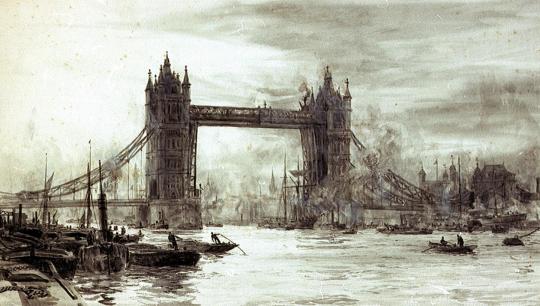
#Remnants of a Legendary Typeface Have Been Rescued From the Thames River#Doves Type#printer#Society of Thames Mudlarks#mudlark#mudlarking#ancient#archeology#archeolgst#history#history news#long reads#long post
78 notes
·
View notes
Note
I just wanted to let you know that I just found your tumblr within the past week and you have immediately become my 2nd favorite tumblr, being only behind Blogatog. Love your ttrpg takes.
Anywho, you said to ask about flags, so what is your biggest/are your biggest red flags when it comes to ttrpg design?
thank you! i'm glad you enjoy my silly little posts. anyways i think my biggest red flag is unintentionality--the feeling that the writer of a TTRPG has done something by 'default', the inability to put myself in their shoes and understand (or even better, be told by the text itself) the reason why a particular decision has been made.
one of the biggest places this rears its head is in terms of tone and voice. let me quote jay dragon's really good the storyteller technique:
Another advantage of getting to know the narrator of your RPG is that it helps mitigate unconscious bias in your design. Dungeons & Dragons has a notably anthropological narrative voice, explaining other cultures and creatures like a scientist in the field. The language of D&D mimics the writing style of mid-century scientists traveling to “exotic” locations and cataloging non-Western experiences as part of a documentation of the Other. It’s easy for newer designers to want to “write a game like D&D” without regard for how even the narrative voice of Dungeons & Dragons carries unintended political baggage. Is a bird’s-eye and judgemental perspective really the energy you want to bring to your whimsical fantasy world? Or is there another perspective within your world that can be more useful, and allow you to find new perspectives on the world you’ve created.
narrative tone is a choice--the attempt to use a 'neutral' tone for rules text and description is also a choice, how formal and how informal you get with it is a choice, and when i read a text that seems to have made that choice thoughtlessly it imo bodes very poorly for the rest of the game.
other examples of this kind of unintentionality are games that have a comabt system despite not being about combat in any way--games with equipment rules despite them not setting out to tell the sort of story where which sword or gun a character has matters--games that measure themselves in exact distances without actually using a battlemap--&c.
while most of this unintentionality takes the form of 'falling back onto what DND does' because DND is the market leader and many people's first TTRPG, so imitating it without purpose is something that both cynical market-share chasers & unexperienced designers without a wide range of expereicne can do--it's absolutely not unique to it. one form of unintentionality i see a lot in indie TTRPG circles is creating far more Moves for your PBtA game than necessary--clearly more out of a sense that 'AW/MotW/Masks has a Move for this' than any specific understanding of what that move will do in your game
in game design--as in any art--there is no such thing as a 'neutral' choice or a non-choice. there are only choices, and how much someone's thought about these choices is important!
359 notes
·
View notes
Text
Sometimes self care is rewatching Dune (2021) and going on and on about ‘the symbolism of this or that’ or how ‘something here is a nod to the sequels’ or ‘look how the casting characterizes the house atreides’ or ‘the music here is phenomenal, it foreshadows gurney’s fate later on’ or ‘I think the difference in the vocalizing in the soundtrack here is deliberate’ until whoever you’re watching it with is ready to commit murder to shut you up.
But it’s just so phenomenal that you can watch it and catch new things each time, the visual and auditory storytelling in the background gives you so much! All these little things that go unnoticed until you see and want to jump out of your seat at them, let’s talk about that.
Let’s talk about how Jessica is always hooded when her scenes are associated with her Bene Gesserit powers and upbringing, how you can literally watch her out her hood down or up mid scene as she transitions from mother and concubine to an obedient disciple, how it foreshadows her struggle in the books all the way through Children of Dune.
Let’s talk about how well done the foreshadowing of the jihad is, how even this early on we can see the start of what is integral to Paul’s conflict in Messiah, how that feeling of helplessness about a destiny he doesn’t want will keep him frozen and unable to stop what’s in motion, how Messiah is such an incredible book because it ties into the dystopian trope wherein revolutionaries become like those they once revolted against, but how it’s so much more fascinating than some of the ways we see it in modern dystopias, because it’s the main characters who are following the pattern, not just watching in horror as those they fought with change for the worse, but actually experiencing it, horrified at what they’ve done and what they will continue to do, frozen and so unable or unwilling to do what needs to be done to stop it, how the movie is still in the stage where they are noble and valiant, but it makes sure to show the dread of what it coming, how it does such a good job of showing the burden of foresight that is so integral to Dune, the way that even as they see the future and can attempt to change it, they know that no matter their decisions, horrible things will come, how it shows Paul as scared hating the power he was given and blaming his mother and her aspirations, how the atreides family never wanted to be great, they wanted to be good, how Paul is coming to see that great and good cannot always coexist, how you look at this boy and you can genuinely see how he will become the man saying ‘Believers, all of them’ how Dune is such a hard story to get right because you watch someone devolve and stand by why horrible things are done without seeing him as a terrible person from the start, without the boy and the man seeming irreconcilable from one another, how the movie actually is on the right track even though the end result is unpalatable to the majority of society, how they are showing the white savior trope in a way that is thus far complaint with how it is deconstructed later on, how they have the epic notes of the beginning without going in a direction that makes the ending impossible.
Let’s talk about how they cast the Atreides family as beautiful people, but not soft, not tamed to modern standards, aristocratic in their looks in such a way that you believe they have been nobility for centuries, maybe millennia, slightly untouchable, dangerous, like those in power during the Italian Renaissance, how Paul looks young but also ethereal and formal, the balance between boy and duke and messiah in his appearance, how Leto’s hair and beard make him not only regal but worn by politics, cold and formal yet fatherly all at once, how Jessica’s ghostly pale complexion nods to her Harkonnen ancestry in the books and how she is beautiful in a way that seems not entirely human, how the other members of the Atreides house are each unique and full of character, not designed to fit a palette or aesthetic, whereas the Harkonnens have an eerie similarity that shows how little they value free will, how the Harkonnens are not dramatized to emphasize their characterization but rather understated, devoid of emotion save for rare explosive moments, how they echoed this in their design, making them blank slates, taking away rather than adding, leaving them almost human, but not quite, enough to trigger that ancient animal instinct in a person that says ‘something is wrong here, something is dangerous’ rather than making them fit in with the conventions of a time period or trend as to how to look evil.
Let’s talk about the soundtrack, how the epic music playing when House Atreides lands on Arrakis is echoed as Gurney and his men charge at the Harkonnens who so greatly outnumber them, how this not only ties you emotionally to the battle, hearing this dying cry of the Atreides, more so than the music continuing to be dark and foreboding through it all, but also how it foreshadows the survival of Gurney and the small group of men with him, living to reunite with Paul later on.
Let’s talk about how throughout the soundtrack we have women vocalizing, the emphasis on the power of the Bene Gesserit and how in Leto’s death scene we diverge from this trend, how he was so powerless against all these grand plans but he still took a stand, still ended things on his own terms.
Let’s talk about how Jessica doesn’t answer when Leto asks her to protect Paul as a Bene Gesserit. Let’s talk about the bull and the matador, the symbolism there. Let’s talk about the emphasis on medieval and renaissance headdresses on the Bene Gesserit, the significance of choosing attire from a time when the Catholic Church was in the peak of its power. Let’s talk about the nods to Gurney’s music. Just, look at all this stuff in the movie that you barely even notice, the first time. All the planning that went into it, how to fit in all these little nods, how to stay true to who the characters are in the present while also beginning to show who they will become. Let’s talk about it.
Though maybe not to the people I was watching the movie with. I don’t actually have a death wish.
#dune#dune frank herbert#paul atreides#children of dune#dune messiah#lady jessica#leto atreides#dune 2021#visual storytelling#soundtracks#movie appreciation#wow this got long#that part in messiah when he says ‘believers’ hits me like a punch in the gut
479 notes
·
View notes
Text
Somewhere out there a millennial is getting an absolute dream house (be it mid century modern, contemporary or 80s) tearing out the walls, all unique features and painting it white and beige.
I see one more absolute horror show of a renovation and I’m sneaking into these housing. Painting color on the wall and re-Pop Corning the ceiling out of spite
Just buy a new construction it already looks like how you want I’m fucking begging you. HGTV has been the same for nearly 30 years and has absolutely destroyed design “pop of color” that’s a slightly different grey! (I hate you open floor plan. I hate you so so so much)
#interior design#home design#renovation#mid centruy modern#space age#contemporary design#80s homes#sad beige
23 notes
·
View notes
Note
You’re welcome, sorry this about the Dahomey.
I know you’re Canadian, but why wasn’t my people, the black community taught about the Dahomey?
People done DNA research and discovered what groups most Africans in north America came from and figured out which routes we came from. And when I got into tumblr I learn that most Africans were second handed sold off by other Africans
(Which is damn near impossible to find in American education courses including college stuff. Jeez I wonder why?)
Then the women king trailer came out, it was people like you not people in positions, tell me in the black American version of “Jews lionizing the Nazis”
I’m sorry if I sound like mess, but the truth about women king shown the core of my existence? We weren’t my people taught about our first oppressors? To keep this pan African bullshit alive? To keep African Americans and native Africans relationships toxic as fuck as my community have a fetishized view in Africa even as fully grown adults? To make sure my people never heals?
Sorry, perhaps we can talk about it in the DMs, but it just…how could Hollywood make this movie? How could popular black actors agree to do this film? Do they have such hatred towards white people in their souls?
I think I will never recover from such revelations. Perhaps I can teach the next generation of black Americans on why we can never truly call Africa home
Also, my people situation is why I can’t buy decolonize USA, where the fuck I’m supposed to go? The Dahomey purposely made sure I can never call Africa home so 🤷
Well it depends, the Dahomey are taught about, the issue is with American education, the Trans Atlantic slave trade isn't taught about in great detail.
The education system simply states Europeans enslaved Africans, it doesn't state how slaves were procured, who procured them, or why Africans were chosen over other people.
It glosses over the fact the Trans Atlantic slave trade brought most of the slaves to South and Central America, how American slavery was mainly indentured servitude until Anthony Johnson, a freed slave, changed that, etc etc.
People are taught slavery is a uniquely European advent, that Africans only went into the Trans Atlantic slave trade, ignoring the Barbary pirates and the Islamic slave trade, I can go on, the point is, they aren't taught the facts because the education system is not designed to educate, it is designed to create factory workers, it's an antiquated system, a product of the Industrial Revolution.
Today we are in an information revolution, we have more access to information today than anyone in history, education needs to be tailored to this, to critical thinking and understanding information, and it isn't, but that's enough of my rambling about the education system.
Well, yes, we know that a majority of African diaspora who came here from the Slave trade came from West Central Africa, they came from the Slave Coast, as it was called then;
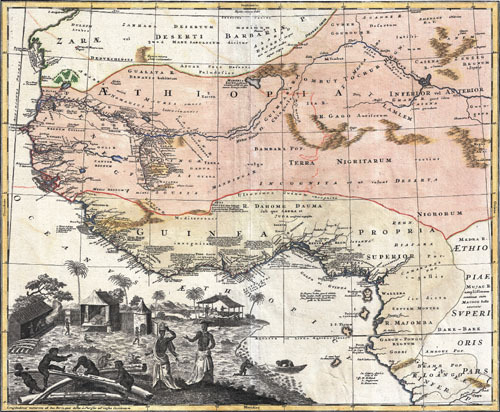
This region is where the Slaver Empires rose and fell, and it wasn't Europeans who established them, it was however Europeans who took advantage of them, enriching them.
The core of your existence isn't slavery, that is a mindset you must abandon for it will destroy you, everyone has dark times in their family history, it's what we choose to keep with us that defines us, the Holocaust doesn't define me, nor does the Potato famine, Irish slavery, or Fascist Italy, I choose who I am, and what I keep within me.
Yes, Pan-Africanist ideas first began to circulate in the mid-19th century in the United States, led by Africans from the Western Hemisphere.
It was an attempt to create a sense of belonging, or brotherhood and collaboration among all people of African descent whether they lived inside or outside of Africa.
It isn't very successful, as it ignores the different, often opposed cultures of Africa, and holds to a very American idea that they are the same because of their skin, it's the same notion behind other organizations like the European Union, the CCP, and of course Nazi Germany, not saying Pan Africanism is Nazi-esque, just that the idea of a Pan racial state is a very common theme.
Where was I going with this? Oh yes, it lead African Americans to view Africa in a very fetishistic and idealized way, the same way European Americans had at one point viewed Europe.
It isn't some malicious push by someone or something to keep African Americans down, or ignorant, it's simply a combination of a poor education system, and common tribalism, nothing other groups haven't suffered from, or continue to suffer from.
Hollywood made it because slavery movies sell, their ESG goals were also met by making the Africans the heroes, and having a female lead, that's it.
Oh yeah, teach your children proper history, don't rely on the education system.
Oh don't worry, the decolonize crowd excludes non white people from those they wish to eject from the US, though they seem to call Asians white.
49 notes
·
View notes
Text
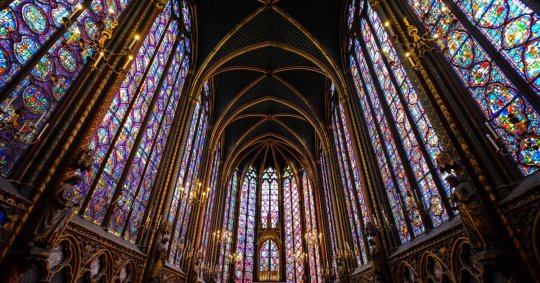

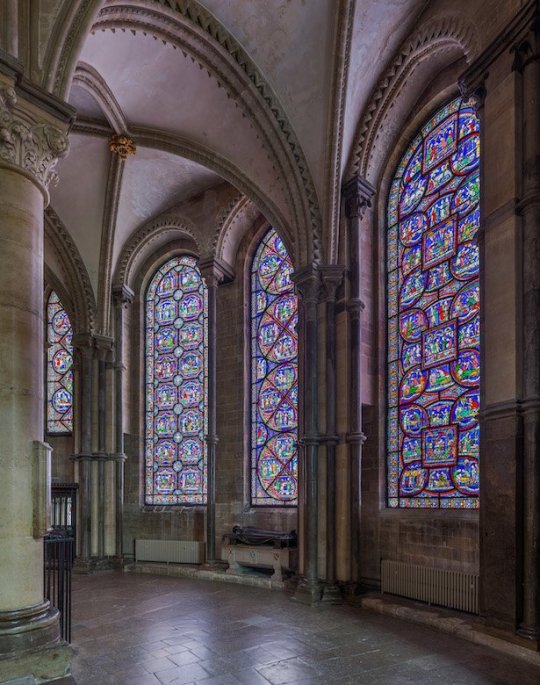
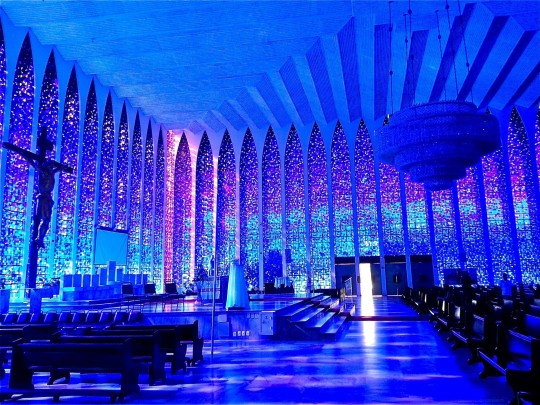

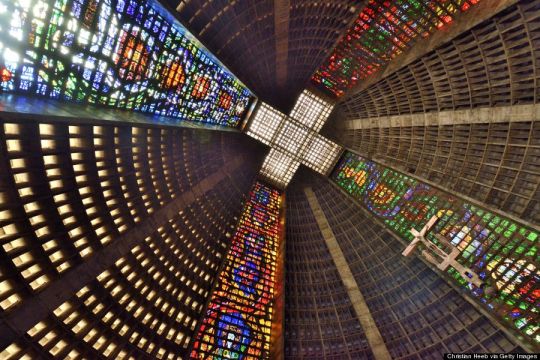

stained glass windows I can't get enough of.
1/ Sainte-Chapelle, Paris
The stained glass windows in Sainte-Chapelle form a drenched masterpiece of stained glass with 15 immense bays of vibrant colors and intricate biblical scenes. These 13th-century windows document the scenes of the Bible, from Creation to Apocalypse.
2/ Cologne Cathedral, Germany:
The stained glass windows of Cologne Cathedral were done in a number of periods, such as the 14th and 16th centuries, when some windows, including the St. Peter window and the Tree of Jesse Window, date from 1509. The design for the window of the south transept of the cathedral was done by Gerhard Richter, finished in 2007, with 11,263 glass squares in 72 colors.
3/ Canterbury Cathedral, England:
The stained glass of Canterbury Cathedral dates back to the 12th century, with some panels thought to be among the oldest in the world. In fact, the oldest glass within the building is over 840 years old, showing biblical figures and their genealogies. A range of the Ancestors of Christ series, dating from the mid-1100s, possibly constitutes the oldest surviving stained glass windows in England.
4/ Santurio Dom Bosco, Brazil
The stained glass of Santuário Dom Bosco in Brasilia was designed by architect Cláudio Naves with Hubert Van Doorne in the 1960s, it contains giant walls in stained blue glass with rosé glass at each corner, creating a really dramatic interior illumination.
5/ Grossmunster Zurich, Germany
The stained glass windows of Grossmünster Zurich were designed by Sigmar Polke and installed in 2009. The windows feature seven windows in the nave made from agate, which were cut into thin slices through which light was passed to create a brightly glowing effect. Five further figurative windows, depicting Old Testament figures leading towards the chancel window created by Augusto Giacometti in 1933.
6/ Metropolitan Cathedral of St. Sebastian, Brazil
The stained glass windows of the Metropolitan Cathedral of St. Sebastian were designed in an intricate symbolism in the city of Rio de Janeiro. The windows, from the 1960s, stand as a symbol of the unity, sanctity, mission, and hierarchy of the Catholic Church. They are part of the unique architecture that boasts a Greek cross and a round base drawing inspiration from Mayan pyramids to mean closeness to God.
7/ Augsburg Cathedral, Germany
The oldest of these stained glass windows are found in Augsburg Cathedral and date back to approximately 1065. Five Old Testament figures—Moses, David, Daniel, Hosea, and Jonah—are depicted in the Prophet Windows of the nave in monumental Romanesque style. Biblical scenes and stories of the Virgin also appear in later medieval windows.
#stained glass#cathedrals#sainte chapelle#cologne cathedral#canterbury cathedral#santurio dom bosco#grossmunster zurich#Brazil#metropolitan cathedral of st Sebastian#Augsburg Cathedral
14 notes
·
View notes
Note
tell me about french train headlights
They're all the same! Or at least they were, from the mid-1950s to about the early 1990s. They all look like this:
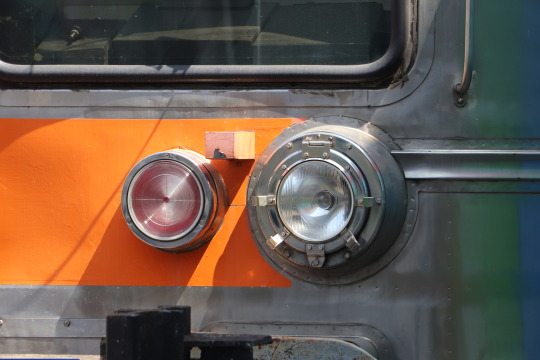
Okay, some context for why I find this interesting. Suppose you see a picture of a train, especially one made in the second half of the 20th century, and you want to know where the train is from. The key trick to telling this at a glance is having a bit of autism, but more specifically, the headlights.
In Europe, all major and many minor countries used to have their own government-owned railroad and their own train-building industry, which would build trains to the specifications of their railroad company. There has always been some exporting going on, but for the most part, the trains you'd find in Germany, France, Switzerland, Austria and so on would be all completely different. This has changed drastically over the past 20ish years.
One thing about this old model is that railroad companies would standardise certain parts within their fleets, especially small parts that need servicing and replacing every now and then. It saves on how many different types of spare parts you need to have.
Headlights are the most notable among these by far: Every train needs to have some of them. All trains have basically the same requirements for their headlights, no matter how fast or slow or whatever they are. Before LEDs, you needed to service the headlights regularly to replace the light bulbs, and as glass parts at the front of a fast moving vehicle, they can get damaged, so spare parts logistics are an issue. And most importantly, we as railfans can easily see them. So you get something like this:
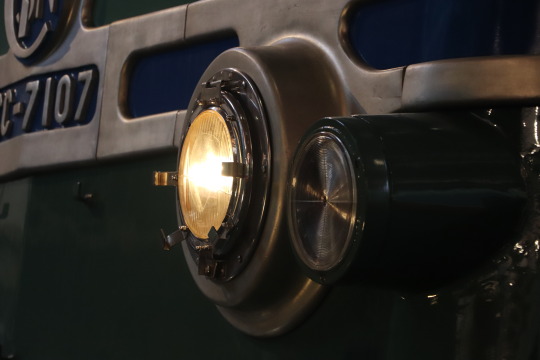



As a result, basically all railroad companies in post-war Europe standardised their head- and taillights for all or most of their trains. And all of them had completely different ideas. Fundamentally, all of them agreed that you need white headlights and red taillights, and since modern trains are easily reversible, you put both of them next to each other.
But do you make the white and red lights the same size (West Germany, Netherlands) or different sizes (Austria, East Germany)? Are they separate things, or do you combine them into one assembly (UK, Switzerland)? Do you make them anything approaching normal sized or gigantic (Poland)? Maybe I'll do an overview post over these later, but I don't have enough pictures in my library right now and I'd have to scour Wikipedia for them later.
The French headlight design shown here is in many ways just one of many, but also interesting in its own right: The actual lenses for red and white are the same size, but the white headlight gets this huge lens assembly that makes it look much more prominent. You can clearly see that different French designers had very different ideas about whether you the center-lines (most of them), or the bottom of the lens assembly. Why is the headlight lens so big, and what are the metal was around the bottom half of the circle? I have no clue. My guess is to put some coloured glass panes in, but I have no idea why you'd need that. Also, note that the red taillight classically has a fresnel lens, that's unique as far as I can tell.
I've taken all these pictures in the Cité du Train, the big central French railroad museum in Mulhouse. (That's why I was posting about traveling to Basel early this weekend. Mulhouse is actually really close to Basel, and going via Switzerland is the most practical—and most scenic—route for me) The oldest locomotive I could find with these headlights was CC-7107:

During high speed trails in the early 1950s, this locomotive reached a speed of 326 km/h (203 mph). That made it only second best behind the other locomotive at the trials, BB-9004:

This one reached 331 km/h (206 mph), a world record that would not be beaten for a long time. The difference was nothing to do with technical performance. Instead, both locomotives melted their pantograph, the part on top that touches the overhead line to get power, at around 320 km/h (200 mph). BB-9004 had a second one that it could lift up to continue accelerating, while CC-7107 only had the one. For a long time, SNCF pretended that both locomotives had reached 331 km/h, to protect the reputation of both manufacturers.
What's notable for our purposes is that BB-9004 has different headlights. As far as I can tell, these seem to be an earlier standard design, also found e.g. on the CC-65001 diesel locomotive:
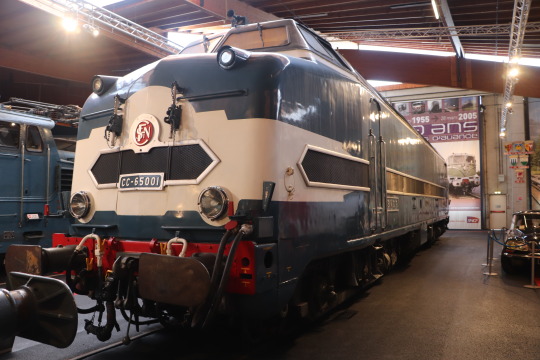
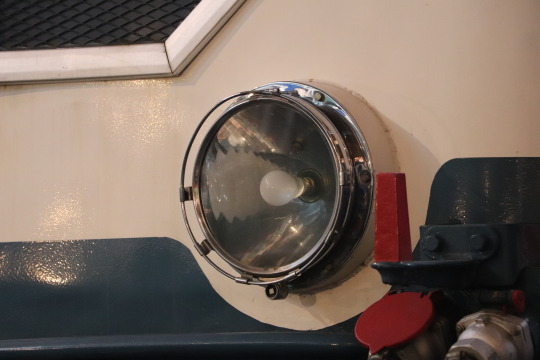
And even on steam locomotives, like this class 141 R:

So CC-7107 lost on the high speed world record, but it was the way of the future when it came to headlights. These headlights then started cropping up everywhere. From the detail pictures I've shown you above, we have e.g. Le Petit Gris (the small grey one, an EMU for suburban services in Paris):

A CC-6500, dressed up with a nameplate for the express train it was hauling. Fun fact: One locomotive of this type (not this one) was used in the US for a while, as Amtrak was trying out new electric locomotives to use. They weren't happy with it and bought a Swedish one instead, mostly because this locomotive's suspension did not work well with the American track quality.
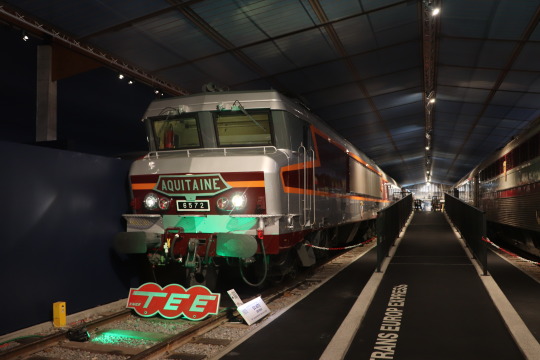
A Z 2200, a diesel railcar for rural lines designed to be cheap first, second and third.

A BB-26000, which feels altogether way to new to be in this museum.

It's from the 1980s, so I guess the first are reaching retirement age. But at the same time: The train I took from Basel to Mulhouse was still pulled by one of these BB-26000.
Other favourites include the BB-25600 with its rare diagonal light arrangement:

Or the really terribly lit gas turbine train RTG, which puts the headlight on stalks:
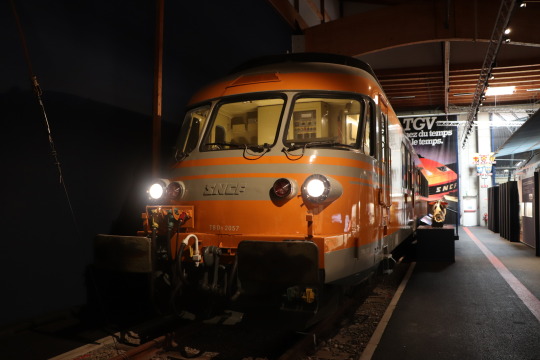
Fun fact: Amtrak did end up buying a few these. They didn't use the same white headlights (although they did use the same stalks), but they did use the same fresnel lens red taillights.
And the headlights went all the way up to the top. To the TGV. Only these headlights aren't very aerodynamic, so for their high-speed train, SNCF decided to cover them up.
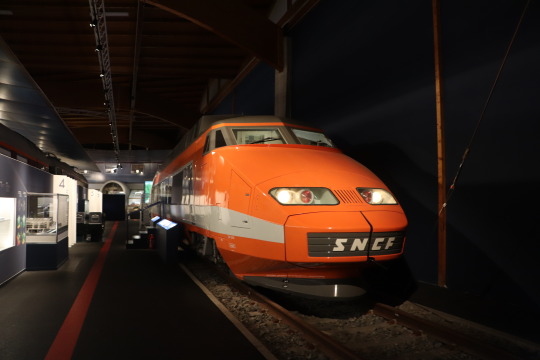
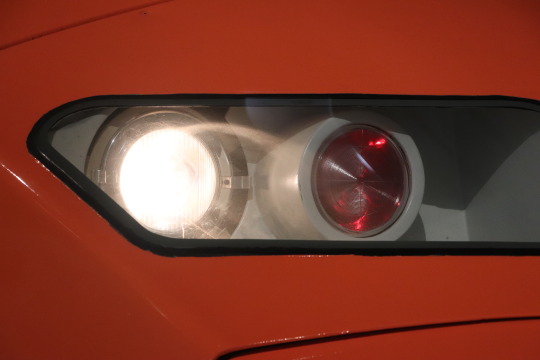
As far as I can tell, SNCF used these headlights in the TGVs up to the Réseau series, including the Eurostar. That meant that they're also found, though behind faded glass, on the TGV Atlantique 325 in the outdoor area. Number 325 is notable because it was involved in another high speed trail, and reached 515.3 km/h (320.3 mph) on May 18th, 1990.



That was a world record, of course; in fact only the French ever exceeded 500 km/h on conventional railroads. So these headlights did get their world record after all. They didn't get to keep it for long, though. In 2007, a newer TGV reached 574.8 km/h (357.2 mph). That one is still in service, though, and it was equipped with newer LED headlights. I think it's highly unlikely that this record will be broken anytime soon, but if anyone does, I wouldn't be surprised if it were the French again, they like that sort of stuff.
Some final odds an ends with the headlights, though: Here's CC-40101, which isn't actually relevant, I just like the way it looks.

Designed for service in France, Belgium, the Netherlands and Germany, with four different voltages and four different train control systems, and that with mid-1960s technology. It wasn't quite as successful as hoped, and in service it only ever reached Belgium, but still, look at that design. The front is supposed to evoke an athlete, a sprinter about to start, but this type of design has instead become known as "Nez cassé", broken nose.
BB-9291 shows a rare early version without red tail lights at all. Someone thought they were saving money.
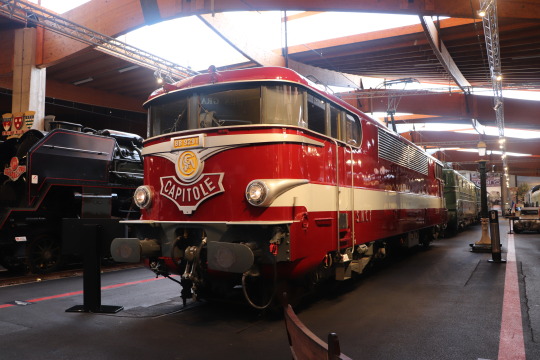
This small work train has a free-standing version of the headlight, which shows us how deep it really is. Apparently, the French headlight is actually not that deep, and isn't that a nice summary for this post?
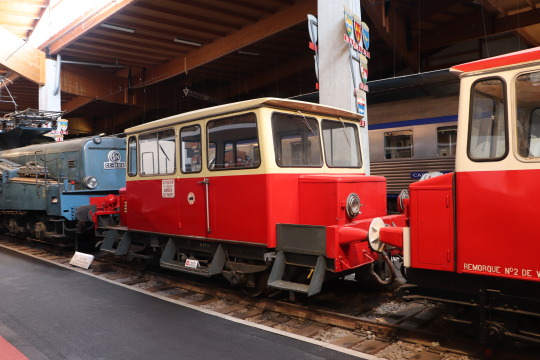
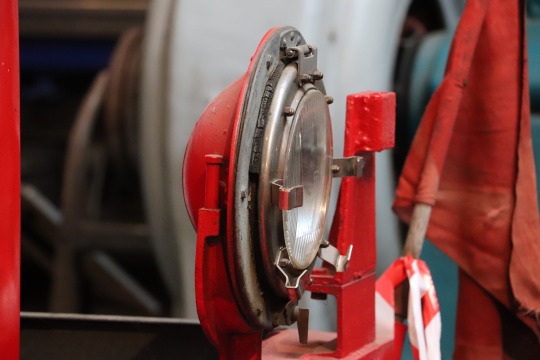
And a personal favourite of mine, I even bought a T-Shirt with it on it, the Z 600:
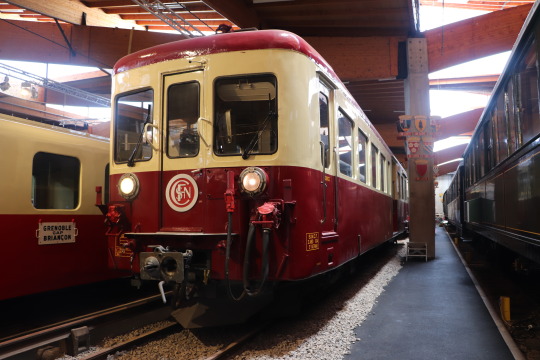
The design, in particular the side windows (recessed instead of flush, no outside visible gasket) says Swiss, the headlight and SNCF logo says French, it's narrow gauge and it has a third rail to provide power. Just all around a weird little train, for the weird little line known as the Mont-Blanc Express from France via Switzerland to the bottom of the Mont-Blanc mountain. The train was built in Switzerland, experts of building small trains for mountains, but for the French part of that rail line, so it got French headlights.
Headlights with exporting is a fun topic in its own right. Do you keep the headlights from the country of origin, or demand your own? You will find both approaches. Both Portugal and the Netherlands bought very similar electric locomotives from France. Portugal has French headlights, the Netherlands insisted on (less interesting) dutch ones.
These days, of course, you will still find these headlights, but they're getting rarer. They stopped being used in new trains around the mid-1990s. What's more, the ones you do find, like on this MI-84 in Paris, probably don't have the fresnel lens taillight anymore. Instead, those were replaced with LEDs.

LED lights for railroads make a lot of sense. They last forever and require less power. And since most railroads have standardised their head- and taillights, you just need to design one replacement light for most of France, and then keep building that one until SNCF stops giving you money.
(Since we're showing a picture from Paris, a quick note: These headlights were never used on passenger-carrying trains for the Paris metro. However, some work trains do have them.)
These days, standard headlights are completely gone. LEDs don't need a lot of replacing, and they give you much more freedom to do things like shapes and patterns and designs. Also, we don't have the "one country, one railroad, one rail industry" pattern anymore. Instead now we have multi-national rail conglomerates. Alstom is technically French, but arguably just as much German, ever since they bought Bombardier's rail division, nominally Canadian. Stadler is Swiss, except for the stuff they build in Germany or Poland or Belarus or Hungary or…, and some of their most interesting products right now are built and designed in Spain.
The end result of that is this:
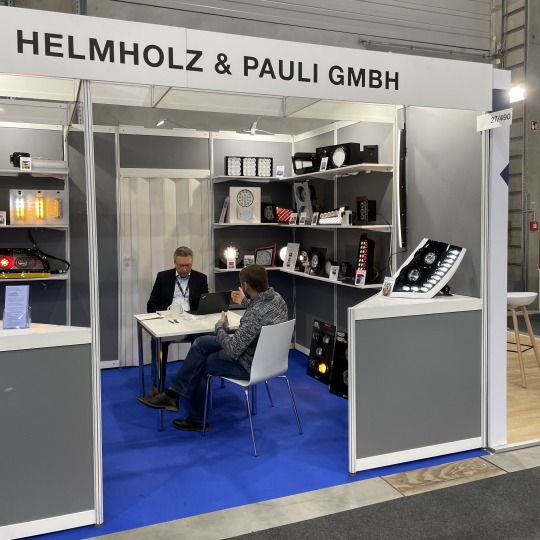
That's a company I saw at a trade fair (Innotrans, Berlin, 2022) that makes LED train headlights, and specifically they make… all of them? Okay, I'm exaggerating, but this is a great picture to drive a European rail fan insane as they try to assign the different headlights to different trains. You get Stuttgart trams, German (and Turkish) high speed trains, lots and lots of Swiss stuff. Nothing specifically French that I could tell, but at least the German high speed train regularly travels to Paris.
The standard headlights, or their LED variants, were still in use for work trains until fairly recently. There are not that many companies that make rail grinders or ballast tampers, and those tend to just use whatever headlight their customer tells them to. But these days they go for shaped LED headlights as well, because they're just better, and because thanks to European standardisation, a headlight approved in one country can (generally) be used in all European countries.
(All pictures © me, feel free to use them under CC-BY-SA 3.0 DE if you want)
55 notes
·
View notes
Text
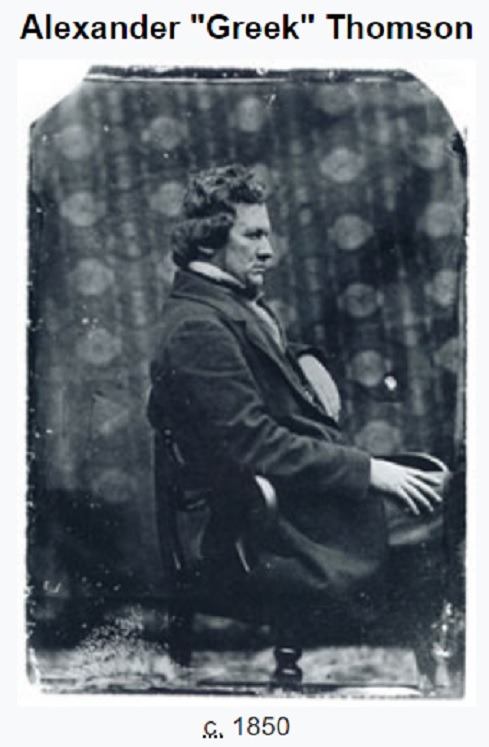



On March 22nd 1875, Alexander "Greek" Thomson died in Glasgow.
Alexander Thomson was born at Balfron in Stirlingshire in 1817. He spent his working life as an architect in and around Glasgow until his death in 1875. He earned his nickname by using Greek Ionic styles in his designs.
In the Victorian era Thomson created some of Scotland's most unique secular and ecclesiastical buildings. Glasgow in the last 150 years has had two of the greatest architects in the world in Thomson and Charles Rennie Mackintosh.
The Caledonia Road Church, where Thomson himself worshipped, fell into disuse as the Gorbals, which had become an area notorious for poor housing and health, was cleared in the mid-20th Century. In 1965 the empty church was torched by vandals and the council, which had responsibility for it, wanted to knock it down.
Another of Thomson's buildings is the St Vincent Street Church in the heart of Glasgow city centre, Thomson's finest villa, Holmwood House in Cathcart, a Victorian suburb about four miles from the city centre, was saved by a small band of enthusiasts 25 years ago and is now cared for by the National Trust for Scotland..
There's a list of his Glasgow buildings at the bottom of this post but with me being an Edinburgh guy I am a wee bit biased and my favourite of Thomson's creations is The Old Royal High School on Regent Road.
Built between 1826 and 1829 on the south face of Calton Hill as part of Edinburgh's Acropolis, at a cost to the Town Council of £34,000 the building is A listed but still faces an uncertain future as developers wanted to build a hotel around the area, the council refused planning permission and the developers appealed to the Scottish Government reporter, who upheld the refusal, this has led to the council stripping the developers of their 120 year lease of the building, and in January it was put back up for sale.
After battling asthma and bronchitis for most of his life, Thomson died on the 22nd March 1875 in the house he designed himself at 1 Moray Place in Strathbungo. He was buried in Glasgow's Southern Necropolis.
Pics are Caledonia Road Church, south Glasgow, Holmwood House and the Egyptian Halls on Sauchiehall Street.
10 notes
·
View notes
Text

The reimagining of Disneyland Resort's Downtown Disney District introduced Parkside Market into the area.
As described by the Disney Parks Blog, this is a "new stage and lawn for special events, activities, musical entertainment and more on the west end of the district. In this brand-new area, you’ll also be able to see a soaring new sculptural tower designed by Nikkolas Smith. This new tower will pay tribute to the sublime work of pioneering architects of color in Southern California during the mid-20th century with unique geometric patterns in the sculpture, evoking the famed mid-century buildings they created."
What that really means is that new trash cans with a mid-century design on the side!
These silver cans featuring a line and circle patterns on the side, with select colored circles creating Mickey heads in the pattern. Both trash and recycling versions have been spotted at Downtown Disney, complete the Environmentality Tree Recycling Icon. Sharp looking design!
// Disneyland Resort, Downtown Disney, Parkside Market, 2023
[Source: MiceChat. Used by Permission.]
#Disney#Magical Trash#Disney Trash Can#Trash Can#2023#Recycling#Anaheim#Environmentality Tree Recycling Icon#Disneyland#Disneyland Resort#DLR#DL#Downtown Disney#Parkside Market
16 notes
·
View notes